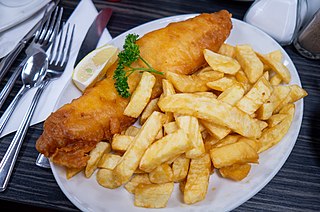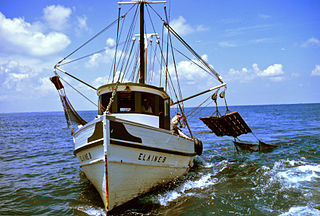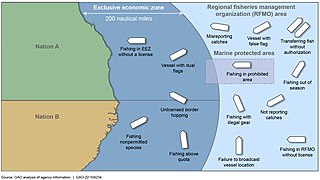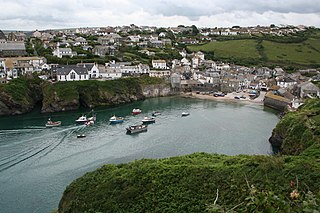History
Seafish was established in the United Kingdom under the Fisheries Act 1981 through the amalgamation of the Herring Industry Board (founded in 1934) [2] and the White Fish Authority (founded in 1951). [3] [4]
Seafish has its administrative base in the Scottish city of Edinburgh and has its research and development base in Grimsby, the UK's main base for the fishing industry and frozen food. The organisation in Grimsby moved into the new Humber Seafood Institute, run by the Grimsby Institute, in July 2008. It was formerly based on St Andrews Dock in Hull.
Seafish carries out research and projects aimed at raising standards, improving efficiency and ensuring the sustainable development of the industry. As well as supplying training and R&D, Seafish operates accreditation schemes for fish and chip shops, fishermen, wholesalers and processors. Seafish has an economics team which collects, interprets and disseminates data about various UK seafood sectors.
Competitions
The National Fish & Chip Awards
The National Fish& Chip Awards recognise shops for producing the best fish and chips in the UK. The competition is split into regional finals and is awarded in late January. It was first awarded in 1988.
Seafish Friers Quality Award
An approved inspector checks the fish restaurant for its image, selection of food raw materials, hygiene and cleaning, handling and temperature control, packaging, management systems, and the training schemes provided. If of a high enough calibre, this award is given, which lasts for one year, giving a reasonable indication of inherent quality. The Seafish website allows you to find recognised fish restaurants in local counties and by speciality fish being served.
Retailer of the Year
Each year a main supermarket chain is given this award. Waitrose won it in 2009.
UK Young Seafood Chef of the Year
The UK Young Seafood Chef of the Year competition is open to all full-time and college based modern apprentice chefs. Highly regarded across the seafood industry for the valuable experience it gives to contestants, the competition provides young chefs with a platform to demonstrate their flair, understanding, skill and ability using seafood from sustainable sources.
Launched in November 2017, teams of two are tasked with creating a three-course menu using specially selected seafood species.
Regional heats take place across the UK, where the young chefs cook their menu with the three highest scoring teams from each heat going on to compete at the Grand Final. [5]
The prize for the winning team includes £500 for each team member, a Robot Coupe food processor and a £1,000 voucher for their college to spend on Russums catering equipment. In partnership with the Grimsby Institute.
Seafood Restaurant of the Year
Launched in 2015, the competition was created to find restaurants demonstrating both excellent examples of the cooking and serving of fish and shellfish, as well as evidence of fish and shellfish knowledge among their staff both front and back of house. In partnership with The Caterer. Previous winners include: The Salt Room, Brighton (2017) [6]
Seafish Responsible Fishing Scheme
The Seafish Responsible Fishing Scheme is a BSi Publicly Available Specification (PAS 72:2006) awarded to individual vessels for vessel operations and traceability in the sea fishing industry. It specifies requirements relating to fishing practices, vessel criteria, crew competence, environmental considerations and record maintenance. It is applicable to the supply chain from the fisherman to the point of first sale. In late 2009 around 500 vessels are involved in the scheme with 325 vessels fully certified covering about 70% of UK landings by weight. The scheme is independently audited by UKAS approved auditors.

Seafood is the culinary name for food that comes from any form of sea life, prominently including fish and shellfish. Shellfish include various species of molluscs.

Fishing is the activity of trying to catch fish. Fish are often caught as wildlife from the natural environment, but may also be caught from stocked bodies of water such as ponds, canals, park wetlands and reservoirs. Fishing techniques include hand-gathering, spearing, netting, angling, shooting and trapping, as well as more destructive and often illegal techniques such as electrocution, blasting and poisoning.

Fish and chips is a hot dish consisting of fried fish in batter, served with chips. The dish originated in England, where these two components had been introduced from separate immigrant cultures; it is not known who combined them. Often considered Britain's national dish, fish and chips is a common takeaway food in numerous other countries, particularly English-speaking and Commonwealth nations.

The fishing industry includes any industry or activity that takes, cultures, processes, preserves, stores, transports, markets or sells fish or fish products. It is defined by the Food and Agriculture Organization as including recreational, subsistence and commercial fishing, as well as the related harvesting, processing, and marketing sectors. The commercial activity is aimed at the delivery of fish and other seafood products for human consumption or as input factors in other industrial processes. The livelihood of over 500 million people in developing countries depends directly or indirectly on fisheries and aquaculture.
The Centre for Environment, Fisheries and Aquaculture Science (Cefas) is an executive agency of the United Kingdom government Department for Environment, Food and Rural Affairs (Defra). It carries out a wide range of research, advisory, consultancy, monitoring and training activities for a large number of customers around the world.

Illegal, unreported and unregulated fishing (IUU) is an issue around the world. Fishing industry observers believe IUU occurs in most fisheries, and accounts for up to 30% of total catches in some important fisheries.

The fishing industry in Scotland comprises a significant proportion of the United Kingdom fishing industry. A recent inquiry by the Royal Society of Edinburgh found fishing to be of much greater social, economic and cultural importance to Scotland than it is relative to the rest of the UK. Scotland has just 8.4 per cent of the UK population but lands at its ports over 60 per cent of the total catch in the UK.

The Anstruther Fish Bar is a fish and chip shop in Anstruther, a fishing village in the East Neuk of Fife, Scotland.
Sustainable seafood is seafood that is caught or farmed in ways that consider the long-term vitality of harvested species and the well-being of the oceans, as well as the livelihoods of fisheries-dependent communities. It was first promoted through the sustainable seafood movement which began in the 1990s. This operation highlights overfishing and environmentally destructive fishing methods. Through a number of initiatives, the movement has increased awareness and raised concerns over the way our seafood is obtained.
The Marine Institute is a state agency in Ireland that provides government, public agencies and the maritime industry with scientific, advisory and economic development services, aiming to inform policy-making, regulation and the sustainable management and growth of the country's marine resources. Founded in 1991 on foot of a 1974 report, the institute undertakes and promotes marine research and development. The agency's staff and operations are governed by a ministerially-appointed board. Based at its headquarters near Galway, it has an office in Dublin and two research vessels.
The Shellfish Association of Great Britain (SAGB) is a historic association that was founded as the Oyster Merchants' and Planters' Association in 1903, it was renamed the SAGB in 1969. They cover a wide range of topics within the shellfish industry, from trading to advice on nutritional standards and also the sustainability of the industry.

The coastline of the Russian Federation is the fourth longest in the world after the coastlines of Canada, Greenland, and Indonesia. The Russian fishing industry has an exclusive economic zone (EEZ) of 7.6 million km2 including access to twelve seas in three oceans, together with the landlocked Caspian Sea and more than two million rivers.
A community-supported fishery (CSF) is an alternative business model for selling fresh, locally sourced seafood. CSF programs, modeled after increasingly popular community-supported agriculture programs, offer members weekly shares of fresh seafood for a pre-paid membership fee. The first CSF program was started in Port Clyde, Maine, in 2007, and similar CSF programs have since been started across the United States and in Europe. Community supported fisheries aim to promote a positive relationship between fishermen, consumers, and the ocean by providing high-quality, locally caught seafood to members. CSF programs began as a method to help marine ecosystems recover from the effects of overfishing while maintaining a thriving fishing community.

The fishing industry in England comprises a significant proportion of the UK's fishing industry. England retains a large but reduced fishing industry. Its fleets bring home fish of every kind, ranging from sole to herring.

Cod and other cod-like fish have been widely used as food through history. Other cod-like fish come from the same family (Gadidae) that cod belong to, such as haddock, pollock, and whiting.
The following outline is provided as an overview of and topical guide to fisheries:
The following outline is provided as an overview of and topical guide to the fishing industry:

A seafood restaurant is a restaurant that specializes in seafood cuisine and seafood dishes, such as fish and shellfish. Dishes may include freshwater fish. The concept may focus upon the preparation and service of fresh seafood,. Some seafood restaurants also provide retail sales of seafood that consumers take home to prepare. Seafood restaurants may have a marine-themed decor, with decorations such as fish nets, nautical images and buoys. Fare can vary due to seasonality in fish availability and in the fishing industry. Seafood restaurants may offer additional non-seafood items, such as chicken and beef dishes.

The Yorkshire coast fishery has long been part of the Yorkshire economy for centuries. The 114-mile (183 km) Yorkshire Coast, from the River Tees to the Humber estuary, has many ports both small and large where the fishing trade thrives. The historic ports at Hull and Whitby are important locations for the landing and processing of fish and shellfish. Scarborough and Bridlington are also sites of commercial fishing.











